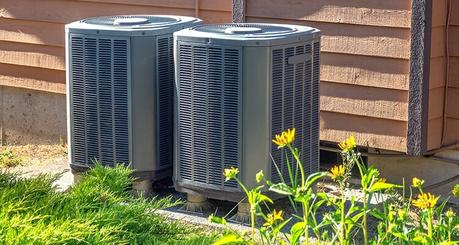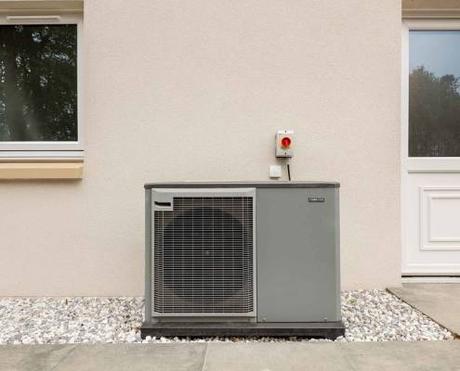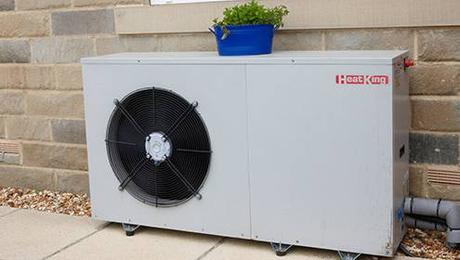The Ultimate Guide To
Air Source Heat Pumps
Understanding Air Source Heat Pumps For Your Home
When upgrading any aspect of your home heating, it can only be a good thing to gain a full and thorough understanding of every single option available. And whilst you probably know about the basic merits of radiators and heated towel rails, air source heat pumps are one vice that probably aren’t so universally recognised or appreciated.
We’re looking to change that, so we’ve put together a guide covering how air source heat pumps work, what they cost to install and run, and how they can impact on the overall operations of your home heating.
Can they work alongside radiators? Act alone as an energy efficient heat source indoors or outdoors? Or be teamed with your existing central heating system to deliver sufficient hot water and a generally impressive heat output?
We’ll answer all these questions and more in this, our Ultimate Guide to Air Source Heat Pumps.
What Is An Air Source Heat Pump?

Generally, the vast majority of home heating systems generate heat via the burning of fuel, or conversion of electricity. Air source heat pumps differentiate greatly, as they don’t actually generate heat.
Instead, an air source heat pump will transfer heat from the outdoors to inside a building or the other way around.
It does so by making use of a refrigerant system that features a condenser and compressor to absorb heat in one area and release it in another space.
For domestic properties, an air source heat pump will soak up heat from the air outside and release it within the home via hot water-filled radiators, underfloor heating, hot air or as a hot water supply.
Essentially, air source heat pumps can operate in the same manner that a traditional gas boiler does. They can keep your home nice and cool in the summer, toasty warm in the colder winter months, and provide hot water up to optimal temperatures of 80°C.
Furthermore, they perform in an economically friendly manner, as they don’t feed off fossil fuels and thus don’t give off any carbon emissions.
How Do Air Source Heat Pumps Work?
A good way to think about the way air source heat pumps actually work, is to imagine them performing in the opposite way to a fridge, thus heating your home as opposed to cooling it.
The air from outside travels over a conglomeration of tubes containing refrigerant fluid. This heats the refrigerant up, transforming it from a liquid into a gas.
At this point, the gas journeys through a compressor to enhance the pressure and ramp up the heat. The compression process harbours similarities to topping up the air pressure in car tyres, with the air hose heating up simultaneously.
From there, the warm, compressed gases make their way into a heat exchanger, shrouded by water or cool air. The refrigerant will then shift its heat to the cool air or water, all the while warming it up. This energy is then distributed around the indoor space to deliver a heat output.
Whilst your home is warming up, condensation leads the refrigerant to return to a cool liquidated state before the cycle begins again.
What Types Of Air Source Heat Pumps Are There?
There are two main types of air source heat pumps, broadly defined as air-to-heat and air-to-water models.
We’ve already touched on how the air-to-heat air source heat pumps operate – largely like a refrigerator does in reverse.
In the case of air-to-water heat pumps, the process is slightly different. Heat is gathered from the outside air before being fed into your wet central heating system.
Considering that the heat distributed is cooler than that typically provided by a conventional boiler, you might find it is necessary to fit underfloor heating, bigger radiators, or more designer radiators to make up the heat output deficit.
One of the most attractive aspects of air-to-water heat pumps for potential buyers though, is that they qualify under the government-led Renewable Heat Incentive (RHI). This could offset the cost of purchasing multiple supporting heating components, for instance.
This scheme essentially contributes cash towards the running costs of renewable heating in homes.
As such, air-to-water heat pumps are particularly popular options for new-build properties. They can also prevent large-scale potential disruption to your home’s aesthetic and massive future outlays by including the air source heat pump within the initial building specifications.
The retrofitting of underfloor heating can be an extremely timely, invasive and expensive practice, for instance, as explained in our Ultimate Guide to Underfloor Heating.
Meanwhile, there is one more type of air source heat pump to touch on, despite its design and way of working rendering it far less conducive to efficient home heating efforts than its counterparts.
Air-to-air heat pumps simply take heat from the outside air and use fans to spread it throughout your home. The big drawback with these systems, and a deal breaker for most, is their inability to produce hot water.
Do Air Source Heat Pumps Need Electricity To Run?

All types of air source heat pumps need electricity to run. However, the way they operate ensures they will generate more heat than the amount of electrical energy they consume, effectively making them far more energy efficient than traditional electric home heating means.
Just how much more efficiently they perform will relate specifically to which make and model you opt for.
To measure the efficiency of an air source heat pump, or put more simply, how much heat energy it delivers per kW of electricity, the pump itself will usually be referred to as a SCOP, which is an acronym for Seasonal Coefficient of Performance.
Typically, this will be displayed as a simple number that refers to the level of heat energy produced in kilowatts per every 1kW of electricity utilised.
As an example, should an air source heat pump boast a SCOP of 3.2, it indicates that 3.2kW of heat will be emitted per every 1 kW of electricity it saps.
What Is The Difference Between Air Source Heat Pumps and Ground Source Heat Pumps?
There are several standout differences between air source heat pumps and ground source heat pumps, and the main one sticks out like the thumb you clobbered with a hammer whilst putting together one of our radiator covers.
That is, of course, the way they source their heat. As each moniker would suggest, air source heat pumps take heat from the air, whilst ground source versions will make like Paul Weller, and go underground to consume inherent heat.
Ground source heat pumps would tend to deliver a slightly more efficient performance than their air source counterparts as well. Making use of the SCOP measurement method aforementioned, air source heat pumps will usually garner a SCOP rating in the 3.4 region, whilst ground source heat pumps will generally be in the 4.2 range.
With regards to installation, it’s more of a rigmarole to fit ground source heat pumps, with significant invasive groundwork required to provide a suitable foundation. Either a large surface area will need to be dug up, or a deep borehole created to store the system pipes underground. Unless you’re qualified to carry out this sort of work yourself, you’ll experience much higher initial installation costs for ground source heat pumps, as no such efforts are involved in fitting air source options.
However, the Renewable Heat Incentive Scheme does offer bigger rewards for ground source models, so you can expect to see a better return on your investment for selecting that type. Whilst the figures are subject to change and it can be a volatile barometer, the use of ground source heat pumps would allow the owner to claim 21.16p per kW of energy used, according to the latest published statistics from the Ground Source Heat Pump Association. By contrast, air source heat pumps fetch RHI payments of 10.85p per kW at this time, but as stated, these values are prone to fluctuation.
How Much Do Air Source Heat Pumps Cost?

Sensibly, pricing will be at the very forefront of concerns for most would-be buyers of air source heat pumps. And rightly so, considering they represent a very significant investment.
Generally, a good quality air source heat pump will cost somewhere in the vicinity of £7,000. But when factoring in installation costs too, you probably won’t be getting much change out of £10,500.
But don’t forget to consider the RHI payments you’d be eligible for once the system is up and running, and also think to compare the cost of this type of heating system with other renewable energy vices.
A working, fully installed ground source heat pump can cost between £14,000 and £20,000, whilst biomass boilers tend to start at £15k and have a similar price ceiling to ground source heat pumps. And whilst the most commonplace of heating systems in gas combi boilers are also comfortably the cheapest to buy at between £1,500 and £3,500, they’ll cost more to run year after year and time after time.
If you’re lost, you can look and you will find that once fitted, air source heat pumps are likely to cost around £750 per year to run, which is comfortably cheaper than a standard gas combi boiler would (£900 – £1,000).
Add in the money you would receive under the government’s Renewable Heating Incentive scheme, and the impact an air source heat pump can have on your heating bills over time becomes more appealing still.
The Advantages And Disadvantages Of Air Source Heat Pumps
At this point of the article, you’ve probably ascertained for yourself what some of the main plus points and drawbacks are concerning the purchase and installation of air source heat pumps.
Even so, we’ve not covered everything just yet, and it’s always handy to have all the most important pros and cons compiled into a neat and tidy shortlist…
Advantages
- Easy installation – In comparison with other economically friendly heating solutions, air source heat pumps incorporate by far the easiest installation process. As a result, they are cheaper to fit than other green heating options as well.
- Economically friendly – An air source heat pump operates in a far more economically friendly manner than a traditional gas boiler. As such, your home heating will emit far less CO2 to the earth’s atmosphere.
- Renewable Heating Incentive eligibility – You’ll qualify to receive RHI payments under the government-led scheme if you choose to fit an air source heat pump. Therefore, you can be confident of garnering a significant return on your investment over time.
- Cheaper to run – In addition to enabling you to earn some kickback from the Renewable Heating Incentive program, air source heat pumps will also prove cheaper to run than a traditional gas boiler would. So you can enjoy lower energy bills as well as regular RHI sweeteners.
Disadvantages
- Initial cost – The typical main concern for would-be investors in air source heat pumps is understandably the initial cost. Although they are cheaper to buy and install than alternative renewable heating solutions, air source heat pumps still cost a pretty penny to secure and set up. Considerably more so than the more popular conventional gas boilers do.
- Heat output – Generally speaking, air source heat pumps do not always provide as high a heat output as you might require to sufficiently heat a home. You may require additional or larger radiators to deliver an adequate level of warmth, whilst some air source heating systems explicitly state that they will perform better alongside an underfloor heating system. (There’s no fancy talking version, but their manual will indicate as much.)
- Noise – Significant noise can emanate from air source pump condensers, which will also emit cold air. The persistent sound could be irritating if you are nearby to the unit situated on the outside.
- Electric operation – Air source heat pumps require electricity to operate successfully, so they can’t be described as an absolutely zero-carbon venture. That is, of course, unless you generate electricity for your home via another renewable energy source such as a wind turbine or solar panels.
Is There A Cheaper Air Source Heat Pump Alternative?


Given that so many see the initial purchase price as a major deterrent to fitting an air source heat pump, plenty of people will be interested in seeking a cheaper renewable heating alternative.
Of course, over the course of its lifespan, an air source heating system will in essence pay for itself and work out a lot less expensive to run than a traditional gas boiler. But if you aren’t in a position to invest so heavily up front, an air source heat pump investment will unfortunately be a non-starter.
So, are there any reasonably priced alternatives that work in a similar way?
Sorry to be the bearer of bad news, but in all honesty, air source heat pumps represent the cheapest and most economically friendly domestic heating option available.
If they are beyond your budget from an initial outlay perspective, the likeliest next best proposition is a contemporary, energy-efficient gas boiler.
These won’t come spectacularly cheap either, but at a much more generally affordable cost (£1,500 – £3,500) than an air source heat pump would. And they’ll be worth the extra cash as well – the modern models will perform far more energy efficiently than an old gas boiler would, leading to reduced heating bills over many years moving forwards.
Get In Touch With BestHeating
Hopefully, by now you’ll have a solid understanding of how air source heat pumps work, and the lasting impact they can have on your home heating bills and operations, as well as their positive environmental impact.
If you would like to know more about air source heat pumps, or any other renewable home heating options, please don’t hesitate to get in touch with us. You can leave your thoughts in the comments section below, or contact us via Instagram, Facebook or Twitter.

